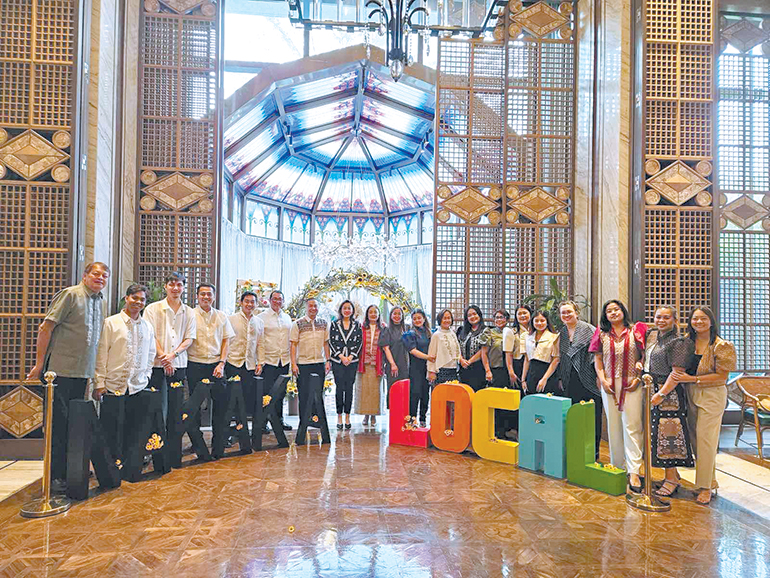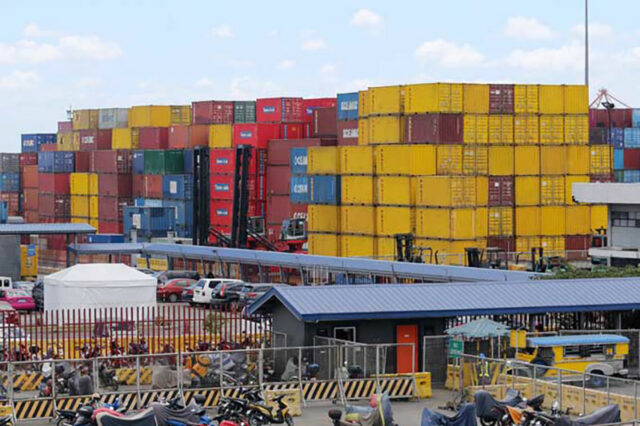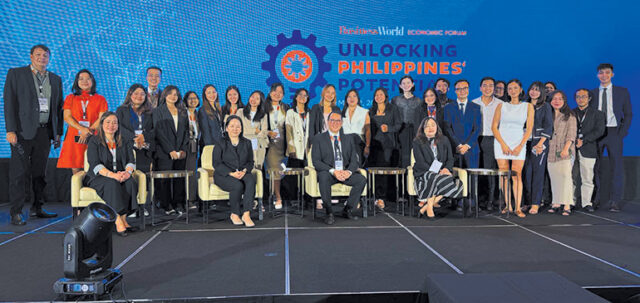Founded in July 1986, The Philippine STAR was born out of a call for press freedom after the People Power Revolution. What began as a single publication later grew into a network under the PhilSTAR Media Group (PMG), with six successful titles and several digital brands.
Since then, PMG has stood as one of the country’s most enduring and adaptable media organizations, remaining relevant and trusted in the modern media landscape. Behind many of the group’s initiatives, PMG Executive Vice-President Lucien C. Dy Tioco has helped lead the company’s growth while staying rooted in its mission to share the truth.
By the time Mr. Dy Tioco joined in 1987 as a branch coordinator for classified ads, The STAR was already laying the groundwork for national prominence. He rose through the ranks and was named advertising director in 2000. In 2012, he assumed the role of senior vice-president for sales and marketing at The STAR. When PMG expanded to include BusinessWorld in 2015, he took on a parallel position. A year later, he was appointed executive vice-president for sales and marketing across both flagship dailies and their supporting brands.
Despite the industry’s transformation due to the prominence of digital media, he has guided PMG’s publications from their newspaper roots into multimedia content providers. Under his leadership, PMG also pushed for advocacy-based campaigns that go beyond the traditional sharing of information.
“I work in an institution where I have the chance to implement positive change, where I can utilize its platforms to do those things,” Mr. Dy Tioco previously said about PMG in a statement.
Early adoption of digitalization
While the coronavirus disease 2019 (COVID-19) pandemic pushed most newsrooms to go digital, PMG had already begun laying down its digital roadmap years earlier.
In 2008, The STAR was already investing in multimedia innovation with “Engage,” a platform that allowed advertisers to connect directly with audiences through branded content.
By 2013, the group rolled out The Philippine STAR mobile app, even experimenting with augmented reality (AR) at a time when mobile internet in the country was still developing. The early step in digitalization allowed the organization to test and grow its multimedia capacities by producing video documentaries, web series, and eventually television programs.
“Newspapers, in general, have largely been guided by set ways and ideals. But The STAR was destined to be different the moment it started,” said Mr. Dy Tioco.
Single/Single, for instance, is a television miniseries produced by PMG and Cinema One. Though primarily a love story, the series promoted financial literacy to younger viewers — a theme rarely tackled by scripted drama. It ran for two seasons, became a movie, won multiple awards, and emerged as one of PMG’s biggest brand collaborations.
The group later expanded into television with Philstar TV, producing shows like Modern Living TV, Wheels, Let’s Eat, and Trippies, which aired on networks such as the ABS-CBN News Channel, CNN Philippines, and One News. These programs often spun off from the paper’s lifestyle and automotive sections, turning traditional newspaper content into video programming.
By 2014, PMG established its own content creation arm, giving it a headstart just as the country’s advertising market began shifting online. The company has since produced viral campaigns, branded content series, and “viewtorials” across social media platforms, tapping into audiences that primarily consume online media.
The company’s out-of-the-box approach reflects the broader direction Mr. Dy Tioco has led it toward over the years. The Philippine STAR has evolved into a multimedia powerhouse, with a footprint that spans digital, mobile, TV, events, and even digital billboards.
“The STAR still prevails to this day. Our digital platforms, social media pages, multimedia capabilities, even our printed newspaper, remain strong and relevant,” he explained. “What drove us to where we are now is our firm belief that a newspaper has a role to serve no matter how the landscape has changed and will continue to change.”
Creating groundbreaking multimedia content
When COVID-19 hit, PMG’s foundation in digital work helped it stay on top. With many people confined to their homes and glued to their screens, the group shifted its content and events online. Journalists and editors kept the newspapers running under extreme conditions, while other teams moved quickly to mount online conferences, livestreams, and digital events that maintained a strong connection with audiences.
During this period, the group launched PhilSTAR L!fe, a lifestyle platform tailored for mobile users. It quickly rose among the most visited lifestyle sites in the country, covering culture-focused content for younger readers.
The executive vice-president also emphasized the value of simplifying subscriptions for both physical newspapers and digital formats through platforms where readers can choose between e-paper and print editions.
PMG continued its digital growth by launching Multiverse PH in 2023, a news site dedicated to covering emerging technologies. The platform features explainers, interviews, and news reports that aim to close the gap between awareness and adoption of emerging technologies.
“Through this platform, we will learn about new technologies that will have an impact on our daily lives and how we can better embrace them,” said Mr. Dy Tioco.
In 2024, the group introduced Philstar NEXT, which formally launched through an event called “Pro Future: AI for Life.” The summit gathered local and international experts, government officials, business leaders, and technology practitioners to discuss the potential of artificial intelligence to improve productivity, support economic growth, and shape future industries.
“Philstar NEXT is the evolution of The Philippine Star, transitioning from storytellers to creators of immersive experiences, transformative narratives, and impactful learning that resonate with today’s ever-changing audience,” Mr. Dy Tioco said in his opening remarks during the event.
Earlier this year, The STAR partnered with startup JuanCast to create “Star Cast Exclusives.” The collaboration introduced a new approach to audience engagement by allowing fans to participate in polls and contests across multiple categories. Through its interactive system, users can show support for their favorite artists and personalities while earning rewards using a built-in virtual currency system called Stars and Suns.
Mr. Dy Tioco called the move a leap of faith, describing the collaboration with a young startup as a strategic step to explore new ways of reaching and engaging audiences.
“Entertainment has always been part of PhilSTAR’s content spectrum, and we feel that ‘Star Cast Exclusives’ is one way of keeping the brand relevant to its younger audiences,” he said.
Aside from digital projects, PMG remains involved in cultural productions. Together with Viva Communications and Newport World Resorts, and in collaboration with the Philippine Educational Theater Association, the group is supporting the stage adaptation of the 1984 hit movie Bagets. Titled “Bagets: The Musical,” the show is scheduled on Jan. 23, 2026, at the Newport Performing Arts Theater.
Advocating for economic and social change
 Beyond news, PMG now invests heavily in community-driven initiatives, allowing the group to stay relevant to younger audiences and different sectors of society.
Beyond news, PMG now invests heavily in community-driven initiatives, allowing the group to stay relevant to younger audiences and different sectors of society.
In 2019, the organization launched Women Today, an annual conference that highlights women leaders and promotes discussions on mentorship and equality. Two years later, PMG introduced She Slays, a youth-centered version of the event focusing on empowerment and building confidence among younger women.
One of the group’s biggest projects to date is Nakakalocal, an advocacy program that supports Filipino micro, small, and medium enterprises (MSMEs). Since its launch in 2022, the program has supported more than 1,250 MSMEs across the Philippines.
“I wanted to create something that could help Filipinos recover from the pandemic,” Mr. Dy Tioco recalled. “Nakakalocal was born out of the spirit of bayanihan, with a mission to uplift local businesses, share their stories, and help build the nation by embracing Pinoy-made products.”
Nakakalocal has since grown from a simple support program into a nationwide campaign that includes bazaars, mall pop-ups, forums, and online training. It has also partnered with private groups to provide MSMEs access to branding guidance, financial literacy sessions, and mentorship from established business leaders.
One of the earliest efforts under Nakakalocal was the “Ready, Set, NeGOsyo” event, which offered step-by-step advice to new entrepreneurs. Later, the “CelebPreneur Forum,” headlined by Judy Ann Santos and Ryan Agoncillo, inspired food business owners through shared experiences and tips. Mall events, including vendor pop-ups and product showcases, helped businesses reach customers directly.
By the end of its first year, Nakakalocal held a major event called “NakakaBazaar: The Grand Nakakalocal Fair” at SM Mall of Asia. The fair brought together MSMEs and Philippine pop acts like BGYO and BINI in one venue.
In 2023, the campaign expanded through a partnership with SM Supermalls. Together, they rolled out the “Bida ang Local” caravan, holding events in Baguio, Batangas, Iloilo, and Davao. That same year, the project launched a national talent search with VIVA, aiming to discover local performers and match them with business-driven opportunities.
Aside from showcasing products and talents, PMG also introduced the Kasosyo bazaar series and EduSerye learning sessions. These programs provided MSMEs with tools for business improvement, including pricing strategies, content marketing, and digital selling techniques.
A year later, Nakakalocal shifted its focus to key industries such as fashion, food, and heritage. The G3n Y to Z Fashion Show and Fair featured Filipino designers and stylists, while Food Fest and Culture Fest highlighted regional cuisines and crafts from different parts of the country.
To help small brands improve their digital presence, PMG launched “Spark Up, Scale Up,” a branding workshop in partnership with Globe. The session focused on online visibility, customer engagement, and practical content strategies.
Besides Nakakalocal, PMG also launched Project KaLIKHAsan, a sustainability drive promoting environmental awareness through innovative ideas and creative solutions. The project takes its name from the Filipino words kalikasan (nature), likha (to create), and samahan (collaboration).
“Through this campaign, we have reached thousands of Filipinos to educate them on environmentally conscious choices, promote sustainable lifestyles, and inspire greater action,” Mr. Dy Tioco explained.
Since its launch, Project KaLIKHAsan has featured a mix of on-ground events, media coverage, and partnerships.
In 2023, PMG partnered with Robinsons Malls to bring sustainability-themed events directly to the public. The series began with a launch at Robinsons Magnolia, focusing on sustainable food practices. The event included cooking demonstrations by local chefs and talks on reducing food waste and using locally sourced ingredients.
In March 2024, “Fashion Forward” at Robinsons Galleria promoted ethical fashion through upcycling workshops, a clothing swap station, and an exhibit of local brands using recycled materials. It also gave visitors hands-on experience with more sustainable clothing options.
By June 2024, Project KaLIKHAsan moved into the arts with “LIKHA: Art for a Change.” The visual arts competition featured works made from biodegradable or discarded materials. A side activity introduced participants to natural paint-making methods used by the Talaandig Indigenous Tribe of Bukidnon.
Later, in September 2024, the project held the “Grow and Glow Plantita Fair” in Laguna to discuss low-waste gardening, composting, and plant care. Local sellers and community gardeners participated in booths and workshops promoting practical ways to green up home spaces.
Most recently, PMG launched “Sine-KaLIKHAsan,” a short film competition encouraging young filmmakers to create stories about recycling, climate change, and environmental justice. Finalist entries will be screened in selected Robinsons Movieworld cinemas across the country.
Aside from mall activations, PMG also supports grassroots efforts such as PSN’s “Wais sa Kalinisan sa Iyong Barangay.” The group conducted a clean-up and recycling awareness campaign in partnership with the Quezon City government. The event also introduced youth participants to citywide recycling efforts like the Trash to Cashback Program and Kilo/s Kyusi.
“Projects like this show how environmental messages can go beyond newsrooms and reach barangays,” Mr. Dy Tioco said. “It is not enough to report about climate change. We have to be part of the conversation and the solution.”
For the executive vice-president, the mission for community building goes beyond profit as PMG strives to “drive meaningful transformation and cultivate enlightened mindsets.” — Mhicole A. Moral








 After earning a degree in Journalism from the University of Santo Tomas in 1985, Mr. Dy Tioco took a detour into music, working at PolyEast Records (then called OctoArts International) in Artist and Repertoire, where he managed local releases of global labels like Virgin, Chrysalis, and RCA.
After earning a degree in Journalism from the University of Santo Tomas in 1985, Mr. Dy Tioco took a detour into music, working at PolyEast Records (then called OctoArts International) in Artist and Repertoire, where he managed local releases of global labels like Virgin, Chrysalis, and RCA. It was during those early days that he saw the value in developing in-house creative and production teams that were capable of producing videos and creating events. The choice to create television-styled content was a strategic one. By bringing STAR sections to screens, they created touchpoints for audiences who might never pick up a broadsheet, positioning the brand as a content engine, not just a publisher.
It was during those early days that he saw the value in developing in-house creative and production teams that were capable of producing videos and creating events. The choice to create television-styled content was a strategic one. By bringing STAR sections to screens, they created touchpoints for audiences who might never pick up a broadsheet, positioning the brand as a content engine, not just a publisher. Recognized for his outstanding leadership and dedication to his job, he was named Asia’s Top Outstanding Netizen Marketeer of the Year at the 2023 AMF Asia Youth, Women Netizen Marketing Excellence Awards.
Recognized for his outstanding leadership and dedication to his job, he was named Asia’s Top Outstanding Netizen Marketeer of the Year at the 2023 AMF Asia Youth, Women Netizen Marketing Excellence Awards.


 Beyond news, PMG now invests heavily in community-driven initiatives, allowing the group to stay relevant to younger audiences and different sectors of society.
Beyond news, PMG now invests heavily in community-driven initiatives, allowing the group to stay relevant to younger audiences and different sectors of society.
